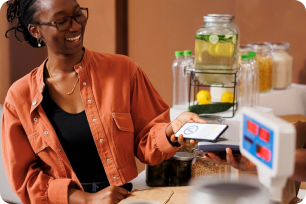Jul 2, 2024
Nearpays Rural Virtual POS Payment System

Digital payment systems have transformed the way we conduct financial transactions. From urban centers to remote villages, these innovations have bridged the gap between traditional banking services and the modern world.
Among these, the Nearpays Rural Virtual POS (RVPos) stands for financial inclusion, particularly for rural areas. The RVPos has the potential to empower millions by offering convenient and secure payment solutions, transforming local economies, and fostering financial literacy.
Understanding Nearpays Rural Virtual POS
The Rural Virtual POS is an innovative technology designed to facilitate cashless transactions in rural areas where traditional banking infrastructure is limited. USSD is a text-based communication protocol that allows users to interact with a service provider's systems through a series of menus presented on their mobile phones.
This method of communication requires minimal data connectivity and is accessible on even the most basic mobile devices.
The RVPos leverages USSD technology to enable individuals, businesses, and service providers to conduct transactions easily. Users can initiate payments, check their account balances, and perform various financial operations through a series of USSD prompts.
This eliminates the need for physical point-of-sale (POS) terminals and bank accounts, making it an ideal solution for regions where establishing and maintaining traditional infrastructure is challenging.

Nearpays Rural Virtual POS
Empowering Rural Economies
One of the key benefits of the Rural Virtual POS is its potential to transform rural economies. In many developing countries, rural areas are home to a significant portion of the population, yet they often lack access to modern financial services. This hinders economic growth, limits business opportunities, and perpetuates the cycle of poverty.
By introducing the RVPos, individuals in rural areas gain access to a secure and convenient way to make transactions. This empowers local businesses to expand their customer base beyond cash-only transactions, fostering economic growth. Farmers can receive payments for their produce without the need to travel long distances to urban centers, reducing costs and saving time.
The introduction of the RVPos also presents an opportunity to enhance financial literacy in rural communities. As users interact with the system, they become more familiar with digital transactions, budgeting, and tracking their financial activities.
This newfound knowledge can empower individuals to make informed financial decisions, save for the future, and protect themselves against potential financial pitfalls.
Benefits of the Rural Virtual POS Payment System
The Nearpays RVPos payment system offers several benefits to users in rural areas:
1. Accessibility: The system can be accessed on even the most basic mobile phones, requiring minimal data connectivity.
2. Convenience: Users can perform transactions without the need to visit physical bank branches or travel long distances to urban centers.
3. Financial Inclusion: The technology bridges the gap between remote communities and modern financial services, promoting inclusion and access to the formal economy.
4. Security: PIN authentication and encryption measures ensure that transactions are secure and protected from unauthorized access.
5. Empowerment: The system empowers individuals, businesses, and service providers to participate more actively in economic activities, boosting local economies.
How the RVPos USSD Payment System Works
The RVPos USSD payment system operates on a simple yet effective mechanism that empowers users in rural areas to conduct cashless transactions with ease.
By dialing *347*465# and following the prompts on their mobile screens, users can seamlessly navigate through a series of menus to initiate various financial activities.
Here's a step-by-step breakdown of how the system works:
Step 1: Dial the USSD Code
Users initiate the process by dialing *347*465# on their mobile phones. This USSD code serves as the gateway to the Nearpays Rural Virtual POS system.
Step 2: Menu Navigation
Upon dialing the code, users are presented with a menu of options on their screen. These options typically include various transactions and inquiries, such as:
- Make payments
- Check balance
- Transfer funds
- Change your pin
Step 3: Selection
Users select the desired option by entering the corresponding number on their keypad. For instance, if a user wishes to send money, they enter '1.'
Step 4: Transaction Details
After selecting the desired option, users are prompted to enter the necessary transaction details. For sending money, this might include the recipient's account number and the amount to be sent.
Step 5: Authentication
To ensure security, the system prompts users to enter a PIN (Personal Identification Number) that they have set up previously. This PIN serves as a protective layer to prevent unauthorized access to their account.
Step 6: Confirmation
Once the transaction details are entered and the PIN is verified, users are presented with a confirmation screen. This screen displays the transaction details, including the recipient's information and the amount to be transferred. Users are prompted to review the information and confirm the transaction.
Step 7: Transaction Completion
Upon confirmation, the Nearpays Rural Virtual POS payment system processes the transaction. Both the sender and the recipient receive SMS notifications confirming the successful completion of the transaction. The sender's account balance is updated to reflect the deduction, while the recipient's account is credited.
Step 8: Additional Features
In addition to basic transactions, the Nearpays system offers users the ability to check their account balance, and access account settings for PIN changes and other account management functions.
Final Words
In conclusion, the Nearpays Rural Virtual POS payment system leverages the power of USSD technology to provide rural communities with a convenient, secure, and accessible way to conduct financial transactions.
By following simple prompts on their mobile phones, users can send money, receive payments, check balances, and engage in other financial activities, ultimately contributing to the growth and development of rural economies.




